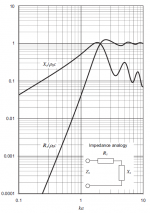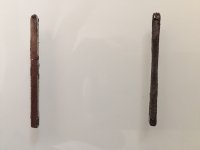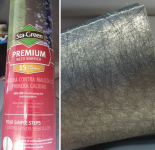It depends on the acoustic characteristics of the felt. If it is fairly thin and firmly attached to the magnets/frame the acoustic impedance will be mainly resistive even up to high frequencies. The result will be that you would see a few dB uniform loss in the upper frequencies on the felt side of the planar compared to the non-felt side. If the felt is thicker, you may see some additional attenuation with increasing frequency. If the felt has such a small effect on the response, you may wonder how it is able to damp the diaphragm resonances as lowmass mentioned? It comes down to the nature of the airload on the diaphragm(also called radiation impedance) and how it varies with frequency. That, and the fact that the moving mass of a planar is so small that the airload dominates its mechanical behavior, unlike with typical dynamic drivers....as the planar is a dipole transducer, with no felt in the front & felt at the rear, will not the frequency characteristics change between front & back sides?
The attached plot shows the normalized radiation impedance for a dipole radiator. It is plotted vs ka rather than frequency so it can be used for any size radiator. When ka=1, the wavelength of sound is similar in size to the piston or diaphragm. So, ka< 1 for low frequencies where wavelength is larger than the radiator, and ka>1 for high frequencies where the wavelength is smaller than the radiator. The Rs curve is the resistive portion of the airload. Notice that at high frequencies Rs is 1, and at low frequencies it is several orders of magnitude smaller. This is why the felt is needed to damp the low frequency diaphragm resonances, because the resistive portion of the airload on the diaphragm is too small to provide any damping. It also explains why the response will be essentially the same on both sides at low frequencies even though it is different at high frequencies. To put some numbers to the acoustic resistances, for high frequencies the specific acoustic resistance of Rs is roughly 400 Rayles on each side of the diaphragm. The specific acoustic resistance of thin (1mm) felt is typically about 100 Rayles.
Several years ago I posted some measurements for felt and polyester mesh used to damp resonances in ESL diaphragms and their effect on the high frequency response. Planar diaphragms behave in the same manner.
Resonance damping: Resonance Control Post#25
HF response: Resonance Control Post#26
You may also be interested to see what the diaphragm modes in a long planar look like.
I posted some measurements and a “movie” of the undamped modes here:
Diaphragm Modes
Attachments
It is a Monsoon planar speaker...which I pulled apart. Now I am planning to change all the magnets after giving them a protective epoxy coating. The only question was the replacement of the felt.
I wish to experiment by placing fine strands of "Angel Hair" in the rear cavity and then stretching a loudspeaker grill cloth taunt in the rear.
I really would love to hear what everyone's advise would be on this.
I wish to experiment by placing fine strands of "Angel Hair" in the rear cavity and then stretching a loudspeaker grill cloth taunt in the rear.
I really would love to hear what everyone's advise would be on this.
Did you have rust on the magnets?
What you will accomplish with the absorbent on the back will be a change in the frequency response to a degree. But as stated above it really depends on the absorber material and it's thickness.
Do you have a picture of the angel hair?
12 inch wide baffle will help you get a little better lower midrange response.
What you will accomplish with the absorbent on the back will be a change in the frequency response to a degree. But as stated above it really depends on the absorber material and it's thickness.
Do you have a picture of the angel hair?
12 inch wide baffle will help you get a little better lower midrange response.
Hi Mark,
Lots and lots of rust...so much so I am replacing all the magnets. The rust has eaten into the magnets! So for the new set I wish to coat them with epoxy... MG Chemicals 4223
More details on Angel Hair may be found at TWARON Angel Hair
I wish to use a fluffed up version of angel hair, under an open weave speaker grill cloth
Thanks,
jsa_ind
Lots and lots of rust...so much so I am replacing all the magnets. The rust has eaten into the magnets! So for the new set I wish to coat them with epoxy... MG Chemicals 4223
More details on Angel Hair may be found at TWARON Angel Hair
I wish to use a fluffed up version of angel hair, under an open weave speaker grill cloth
Thanks,
jsa_ind
Attachments
It is a Monsoon planar speaker...which I pulled apart. Now I am planning to change all the magnets after giving them a protective epoxy coating. The only question was the replacement of the felt.
I wish to experiment by placing fine strands of "Angel Hair" in the rear cavity and then stretching a loudspeaker grill cloth taunt in the rear.
I really would love to hear what everyone's advise would be on this.
Bolserst,s info will go a long way to getting your head around this stuff.
When U talk of "angle hair" and "pulling grill cloth tight" this makes me think of rather loose materials that can become sympathetic to diaphragm movments, meaning they can move with the diaphragm. This arraingment may have some posative effect at damping certain issues BUT thats not likley what the stock "felt" was doing. What were talking about is a material that has a resistance to the flow of air BUT does not itself move at all (ideal). The way to get that is gluing the "felt" solidly to the magnets or frame so that it cannot move but provides a resistance to air flow.
I word on the "felt".... Felt generaly has random fibers that can move, the "felt" typically used on comercial planers is more likley not at all felt but a fiberous mat that is pressed and very thin where the fibers dont move much at all.
Last edited:
You have made a very valid point Lowmass! Thank you! I think I will just stick with speaker grill cloth. I was wanting to try this https://weircrafts.com/wool-felt/undyed-wool-felt.html but I guess it would be too restrictive!
Missed a couple of posts
That is only slightly compromised!
Wow. A perfect example of what happens when you cheap out on magnet suppliers.
Looked at the Angel Hair. Most fibrous tangle type polyester will have very similar acoustic properties. Differing amounts of compression on the fiber will make noticeable difference in the resulting tailoring of the sound. This is an art not a hard and fast science. To many variables to calculate it exactly. There are also stiffer more dense fiberglass panels that you could try. (Think fiberglass ceiling tiles) Not so much for sound absorbing purposes but when fully covering one side you can alter some of the physical characteristics as well. Not quite so greatly as when doing similar things to a woofer, as the suspension system of most planars is pretty stiff to begin with. But alter the response you can accomplish.
Roxul makes a stiff panel that is really good for this purpose to. But not cheap. It's about $60 for a bundle of them. They are really good to taming room reflections to if you have a use for that.
Hi Mark,
Lots and lots of rust...so much so I am replacing all the magnets. The rust has eaten into the magnets! So for the new set I wish to coat them with epoxy... MG Chemicals 4223
More details on Angel Hair may be found at TWARON Angel Hair
I wish to use a fluffed up version of angel hair, under an open weave speaker grill cloth
Thanks,
jsa_ind
That is only slightly compromised!
Wow. A perfect example of what happens when you cheap out on magnet suppliers.
Looked at the Angel Hair. Most fibrous tangle type polyester will have very similar acoustic properties. Differing amounts of compression on the fiber will make noticeable difference in the resulting tailoring of the sound. This is an art not a hard and fast science. To many variables to calculate it exactly. There are also stiffer more dense fiberglass panels that you could try. (Think fiberglass ceiling tiles) Not so much for sound absorbing purposes but when fully covering one side you can alter some of the physical characteristics as well. Not quite so greatly as when doing similar things to a woofer, as the suspension system of most planars is pretty stiff to begin with. But alter the response you can accomplish.
Roxul makes a stiff panel that is really good for this purpose to. But not cheap. It's about $60 for a bundle of them. They are really good to taming room reflections to if you have a use for that.
Hi,
Whether thin layer of felt mounted on the rear of a Apogee bass panel can have influence on famous buzz?
Unfortunatly no. The "buzz" is due to the diaphragm slapping the frame where the foam has rotted away.
Some have eliminated the buzz by pouring low viscosity silicone down in this area. not ideal but it works.
In theory using the felt pads on back of magnet array can have some effect on the buzz indirectly by reduce the peak to peak excursions at main resonance , BUT at best it would be just a small reduction in the noise
Last edited:
A paper on neodymium magnet oxidation that might be of interest was posted here: http://www.diyaudio.com/forums/plan...-aurum-cantus-ribbon-tweeter.html#post3727664…A perfect example of what happens when you cheap out on magnet suppliers….
Yeah, it seems most manufacturers use some form of spun-bound non-woven fabric like what is used as filter media in most air filters. This type of fabric is also used for many other purposes like fabric softener sheets, coffee filters, stabilizer sheets for needle work, etc. One source for a suitable black spun-bound fabric for damping planars can be found at the hardware store in the garden department sold as landscape fabric. The particular landscape fabric shown in the attached pic has a suitable 50-60 Rayle acoustic resistance that is nearly uniform over the whole audio spectrum. It is also pretty strong, so easy to achieve high resonance when gluing to frame or magnets....Felt generally has random fibers that can move, the "felt" typically used on comercial planers is more likley not at all felt but a fiberous mat that is pressed and very thin where the fibers don’t move much at all.
Obviously acoustic mesh fabric like Saatifil Acoustex is ideal for this application, but it is a bit pricey and not readily available. Alternatively you can purchase silk screen mesh of similar thread count, but you won’t know what the acoustic resistance is until you get it and test it. To a first approximation, the acoustic resistance is inversely proportional to the square of the pore size, so thread count is not a direct indicator of acoustic resistance unless you know the thread size too.
More details on acoustic mesh here: Acoustic Resistance of Mesh
Attachments
To get enough damping at low frequencies, you will likely have to compress a considerable amount of the “Angel Hair”. Once you do this you will find that the high frequencies will be rolled off on the side the damping material is placed. This may or may not be desirable for your application. Actually, tightly stretched grill cloth if glued to the rear frame can provide a reasonable amount of LF damping for the diaphragm modes…15 – 20 Rayle for the samples I’ve tested.I wish to experiment by placing fine strands of "Angel Hair" in the rear cavity and then stretching a loudspeaker grill cloth taunt in the rear.
I really would love to hear what everyone's advise would be on this.
What has been suggested is two different methods of damping the rear output of a planar.
The thinner fabric method has effects. The brute force method I suggested has effects.
One thing to keep in mind is are you trying to modify the drivers response? Or are you trying to absorb the rear wave?
The thinner semi permeable fabric will modify the response a bit.
The thicker absorber will absorb quite a lot of the rear wave.
Try a bit of both.
You can start withe the ground cloth as an example and try damping strips if you desire a different change.
The products used in many of the planars on the interior as fiberglass derivatives. Loose semi-woven mats. Their uses are lost in the methods of copying others work. And I can say that with a certainty because I know personally some of the better planar designers and manufacturers. There are many dubious copies of some seminal work out there.
The Monsoon drivers were initially designed by a very good designer. Their failing was chasing the lowest price and growing a little to quickly.
@ lowmass.
If you are interested in waveguide and or horn design work you know where to get ahold of me.
The thinner fabric method has effects. The brute force method I suggested has effects.
One thing to keep in mind is are you trying to modify the drivers response? Or are you trying to absorb the rear wave?
The thinner semi permeable fabric will modify the response a bit.
The thicker absorber will absorb quite a lot of the rear wave.
Try a bit of both.
You can start withe the ground cloth as an example and try damping strips if you desire a different change.
The products used in many of the planars on the interior as fiberglass derivatives. Loose semi-woven mats. Their uses are lost in the methods of copying others work. And I can say that with a certainty because I know personally some of the better planar designers and manufacturers. There are many dubious copies of some seminal work out there.
The Monsoon drivers were initially designed by a very good designer. Their failing was chasing the lowest price and growing a little to quickly.
@ lowmass.
If you are interested in waveguide and or horn design work you know where to get ahold of me.
- Status
- This old topic is closed. If you want to reopen this topic, contact a moderator using the "Report Post" button.
- Home
- Loudspeakers
- Planars & Exotics
- Planar Question



